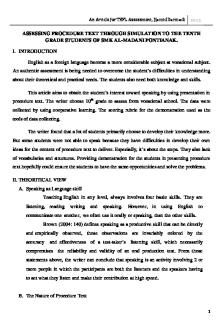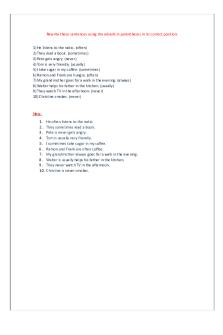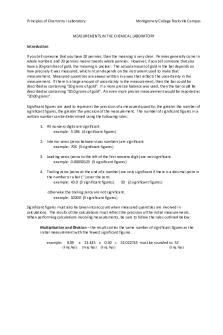The correct laboratory technique in using centrifuge PDF
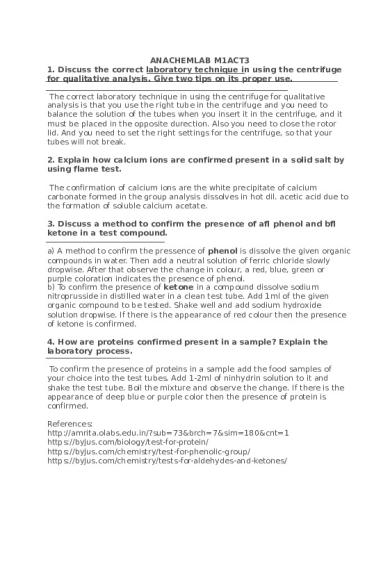
| Title | The correct laboratory technique in using centrifuge |
|---|---|
| Course | Chemistry |
| Institution | Centro Escolar University |
| Pages | 1 |
| File Size | 35 KB |
| File Type | |
| Total Downloads | 544 |
| Total Views | 708 |
Summary
Download The correct laboratory technique in using centrifuge PDF
Description
ANACHEMLAB M1ACT3 1. Discuss the correct laboratory technique in using the centrifuge for qualitative analysis. Give two tips on its proper use. The correct laboratory technique in using the centrifuge for qualitative analysis is that you use the right tube in the centrifuge and you need to balance the solution of the tubes when you insert it in the centrifuge, and it must be placed in the opposite durection. Also you need to close the rotor lid. And you need to set the right settings for the centrifuge, so that your tubes will not break. 2. Explain how calcium ions are confirmed present in a solid salt by using flame test. The confirmation of calcium ions are the white precipitate of calcium carbonate formed in the group analysis dissolves in hot dil. acetic acid due to the formation of soluble calcium acetate. 3. Discuss a method to confirm the presence of a) phenol and b) ketone in a test compound. a) A method to confirm the pressence of phenol is dissolve the given organic compounds in water. Then add a neutral solution of ferric chloride slowly dropwise. After that observe the change in colour, a red, blue, green or purple coloration indicates the presence of phenol. b) To confirm the presence of ketone in a compound dissolve sodium nitroprusside in distilled water in a clean test tube. Add 1ml of the given organic compound to be tested. Shake well and add sodium hydroxide solution dropwise. If there is the appearance of red colour then the presence of ketone is confirmed. 4. How are proteins confirmed present in a sample? Explain the laboratory process. To confirm the presence of proteins in a sample add the food samples of your choice into the test tubes. Add 1-2ml of ninhydrin solution to it and shake the test tube. Boil the mixture and observe the change. If there is the appearance of deep blue or purple color then the presence of protein is confirmed. References: http://amrita.olabs.edu.in/?sub=73&brch=7&sim=180&cnt=1 https://byjus.com/biology/test-for-protein/ https://byjus.com/chemistry/test-for-phenolic-group/ https://byjus.com/chemistry/tests-for-aldehydes-and-ketones/...
Similar Free PDFs
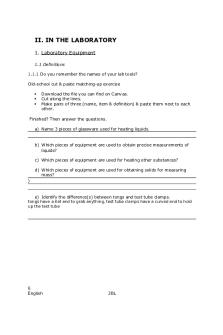
U2 In the Laboratory Std
- 6 Pages

Following the Correct MLA Format
- 3 Pages
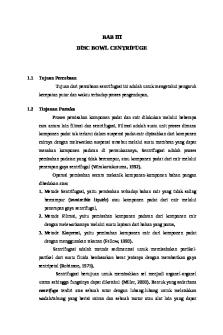
BAB III DISC BOWL CENTRIFUGE
- 9 Pages

Correct Anwsers
- 18 Pages

Correct aankoopdagboek
- 8 Pages
Popular Institutions
- Tinajero National High School - Annex
- Politeknik Caltex Riau
- Yokohama City University
- SGT University
- University of Al-Qadisiyah
- Divine Word College of Vigan
- Techniek College Rotterdam
- Universidade de Santiago
- Universiti Teknologi MARA Cawangan Johor Kampus Pasir Gudang
- Poltekkes Kemenkes Yogyakarta
- Baguio City National High School
- Colegio san marcos
- preparatoria uno
- Centro de Bachillerato Tecnológico Industrial y de Servicios No. 107
- Dalian Maritime University
- Quang Trung Secondary School
- Colegio Tecnológico en Informática
- Corporación Regional de Educación Superior
- Grupo CEDVA
- Dar Al Uloom University
- Centro de Estudios Preuniversitarios de la Universidad Nacional de Ingeniería
- 上智大学
- Aakash International School, Nuna Majara
- San Felipe Neri Catholic School
- Kang Chiao International School - New Taipei City
- Misamis Occidental National High School
- Institución Educativa Escuela Normal Juan Ladrilleros
- Kolehiyo ng Pantukan
- Batanes State College
- Instituto Continental
- Sekolah Menengah Kejuruan Kesehatan Kaltara (Tarakan)
- Colegio de La Inmaculada Concepcion - Cebu


